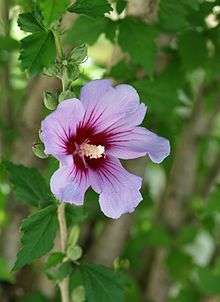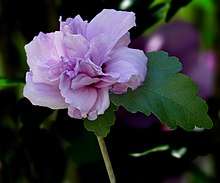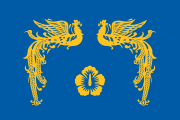Hibiscus syriacus
| Hibiscus syriacus | |
|---|---|
| Scientific classification | |
| Kingdom: | Plantae |
| Clade: | Angiosperms |
| Clade: | Eudicots |
| Clade: | Rosids |
| Order: | Malvales |
| Family: | Malvaceae |
| Genus: | Hibiscus |
| Species: | H. syriacus |
| Binomial name | |
| Hibiscus syriacus | |
| Synonyms[1] | |
|
List
| |
Hibiscus syriacus is a species of flowering plant in the mallow family Malvaceae. It is native south-central and southeast China, but widely introduced elsewhere, including much of Asia.[2] It was given the epithet syriacus because it had been collected from gardens in Syria.[3][4][5] Common names include the Korean rose (Republic of Korea), rose of Sharon[6] (especially in North America), Syrian ketmia[7] or rose mallow (United Kingdom), St Joseph's rod (Italy) and rosa de Sharon (Brazil).
Description
Hibiscus syriacus is a hardy deciduous shrub. It is upright and vase-shaped, reaching 2–4 m (7–13 ft) in height, bearing large trumpet-shaped flowers with prominent yellow-tipped white stamens.[8] The flowers are often pink in color, but can also be dark pink (almost purple), light pink or white. Individual flowers are short-lived, lasting only a day. However, numerous buds produced on the shrub's new growth provide prolific flowering over a long summer blooming period. The soil in which the Hibiscus thrives on is a moist, but well-drained, mixture of sand, clay, chalk, and loam. Maintaining an alkaline, neutral pH (5.5 – 7.0) levels. Hibiscus syriacus is highly tolerant of air pollution, heat, humidity, poor soil and drought.[9] Shoots make interesting indoor vase cuttings, as they stay green for a long time, and some new flowers may open from the more mature buds. The species has naturalized very well in many suburban areas, and might even be termed slightly invasive, so frequently it does seed around.
Growth
The branches are thin and gray, white-lenticeled, with raised leaf scars and small buds. Stems and branches do not branch very much unless pruned, resulting in many long, straight stems that originate from about 0.5–1.5" above the ground that give rise to the shrub's overall vase shape. The leaves are usually green or yellowish green autumn color, alternate, broadly ovate, palmately veined, 3" long leaves. They have 3 distinct lobes with coarsely-toothed margin that create no color in the fall. The trunks are white-gray and relatively smooth, and the branching is very near to the ground unless limbed up into tree form.[10]
Flowers
H. syriacus has 5-petaled flowers (to 3″ diameter) in solid colors of white, red, purple, mauve, violet, or blue, or bicolors with a different colored throat, depending upon the cultivar. Extending from the base of these five petals is the pistil at the center, with the stamen around it. These basic characteristics give the H. syriacus flower and its many variants their distinctive form. The plant can bloom continuously from July through September, usually at night. The 4 in (10 cm) wide, single- or double-flowering, large-petaled, very showy flowers adorn the plant throughout the summer. With maturity, flexible plant stems become weighted under the load of prolific summer flowers, and bend over halfway to the ground.

Fruits and seeds
Most modern cultivars are virtually fruitless. The fruits of those that have them are a green to brown, ornamentally unattractive 5-valved dehiscent capsules, which persist throughout much of the winter on older cultivars. They will eventually shatter over the course of the dormant season and spread their easily germinating seeds around the base of the parent plant, forming colonies with time.[11]
Cultivars

Though it has no fall color and can be stiff and ungainly if badly pruned, H. syriacus remains a popular ornamental shrub today, with many cultivars. They can grow in full sun to partial shade, but the best flowering occurs under sun. Although hibiscus can survive freezing temperatures, they grow best in warm weather, as cold weather can stunt bud growth. They prefer moist, well-drained soils supplemented with organic matter in full sun. Hibiscus also thrives in soil that is rich in potassium and low in phosphorus, but is very adaptable to various soils, soil pHs, soil compaction, drought, heavy pruning, and pollution (and is therefore urban tolerant). William Robinson mentioned several varieties in The English Flower Garden that are still available today. Triploid varieties were first produced at the National Arboretum, Washington DC, by Dr. D. Egolf, resulting in plants that bloom lavishly, as they are sterile and set no seed; Egolf varieties named for goddesses include the white 'Diana'. Also in the market are 'Lady Stanley', 'Ardens', 'Lucy', and 'Blushing Bride'.
Cultivars of H. syriacus are widely planted in areas with hot summers for their attractive white, pink, red, lavender, or purple large and edible flowers. The following cultivars have gained the Royal Horticultural Society's Award of Garden Merit:-[12]
Propagation
Hibiscus syriacus is fairly easily propagated from either seeds, with variable results, or by layering or cuttings, cloning the original.
Pests and diseases
Old shrubs can develop trunk cankers that may eventually prove fatal to the plant.[21] The plant has some susceptibility to leaf spots, blights, rusts and canker. Japanese beetles, whiteflies and aphids are occasional insect visitors. Japanese beetles can severely damage foliage if left unchecked. Whiteflies are especially harmful to the plant, they suck out juices from the underside of leaves. Afterwards, they secrete a substance called honeydew that leads to the growth of a black fungus. Whiteflies are attracted to yellow flowers. Aphids also secrete honeydew, which attracts ants to the plant. Hibiscus beetles are shiny black insects that burrow into the unopened flower, sucking out pollen before it blooms. Females then lay eggs in the bud. Beetles are drawn to white, yellow and pink flowers.[22]
National flower

Hibiscus syriacus, also known as the Korean rose, is the national flower of South Korea.[23] The flower appears in national emblems, and Korea is compared poetically to the flower in the South Korean national anthem. The flower's name in Korean is mugunghwa (Hangul: 무궁화; Hanja: 無窮花). The flower's symbolic significance stems from the Korean word mugung, which means "eternity" or "inexhaustible abundance". Various emblems of South Korea contain Hibiscus syriacus.
History and culture
Hibiscus syriacus has been grown as a garden shrub in Korea since time immemorial; its leaves were brewed into an herbal tea and its flowers eaten. Later on it was introduced and grown in the gardens of Europe as early as the 16th century, though as late as 1629 John Parkinson thought it was tender and took great precautions with it, thinking it "would not suffer to be uncovered in the Winter time, or yet abroad in the Garden, but kept in a large pot or tubbe in the house or in a warme cellar, if you would have them to thrive." (sic)[24] By the end of the 17th century, some knew it to be hardy: Gibson, describing Lord Arlington's London house noted six large earthen pots coddling the "tree hollyhock", as he called it, "that grows well enough in the ground".[25] By the 18th century the shrub was common in English gardens and in the American colonies, known as Althea frutex and "Syrian ketmia".[26] Places like Mexico, Jamaica, Cuba, Filipina, Egypt, Sudan and Europe have their own variation of tea made with the hibiscus flower or leaf.[27] Today the flowers are sometimes made into tea, syrup, jam, and stuffed fritters.
References
- ↑ "The Plant List: A Working List of All Plant Species". Retrieved April 8, 2014.
- ↑ "Hibiscus syriacus L.". Plants of the World Online. Royal Botanic Gardens, Kew. Retrieved 2018-07-29.
- ↑ Lawton, B.P. 2004. Hibiscus – hardy and tropical plants for the garden. Timber Press, Portland, OR
- ↑ Walker, J. 1999. Hibiscus. Cassel, London, England.
- ↑ Alice M. Coats, Garden Shrubs and their Histories (1964) 1992, s.v. "Hibiscus".
- ↑ "Hibiscus syriacus". Natural Resources Conservation Service PLANTS Database. USDA. Retrieved 20 January 2016.
- ↑ "BSBI List 2007". Botanical Society of Britain and Ireland. Archived from the original (xls) on 2015-01-25. Retrieved 2014-10-17.
- ↑ RHS A-Z encyclopedia of garden plants. United Kingdom: Dorling Kindersley. 2008. p. 1136. ISBN 1405332964.
- ↑ "Hibiscus Syriacus 'Notwoodtwo' WHITE CHIFFON – Plant Finder". Missouribotanicalgarden.org. N.p., 2016. Web. 21 Apr. 2017.
- ↑ plantfacts.osu.edu/pdf/0247-539.pdf. N.p., 2017. Web. 21 Apr. 2017.
- ↑ plantfacts.osu.edu/pdf/0247-539.pdf. N.p., 2017. Web. 21 Apr. 2017.
- ↑ "AGM Plants – Ornamental" (PDF). Royal Horticultural Society. July 2017. p. 48. Retrieved 3 March 2018.
- ↑ "RHS Plant Selector – Hibiscus syriacus 'Diana'". Retrieved 22 June 2013.
- ↑ "RHS Plant Selector – Hibiscus syriacus 'Hamabo'". Retrieved 22 June 2013.
- ↑ "RHS Plant Selector – Hibiscus syriacus Lavender Chiffon 'Notwoodone'". Retrieved 22 June 2013.
- ↑ "RHS Plant Selector – Hibiscus syriacus 'Meehanii'". Retrieved 22 June 2013.
- ↑ "RHS Plant Selector – Hibiscus syriacus 'Oiseau Bleu'". Retrieved 22 June 2013.
- ↑ "RHS Plant Selector – Hibiscus syriacus 'Red Heart'". Retrieved 22 June 2013.
- ↑ "RHS Plant Selector – Hibiscus syriacus 'William R. Smith'". Retrieved 22 June 2013.
- ↑ "RHS Plant Selector – Hibiscus syriacus 'Woodbridge'". Retrieved 22 June 2013.
- ↑ Cankers On Trees: Various. 1st ed. Cornell University College of Agriculture and Life Science, 2015. Web. 21 Apr. 2017.
- ↑ "Hibiscus ( Hibiscus Syriacus )". Heritage Garden. N.p., 2014. Web. 21 Apr. 2017.
- ↑ http://www.korea.net/NewsFocus/Culture/view?articleId=75126
- ↑ Parkinson, Paradisi in Sole Paradisus Terrestris, 1629.
- ↑ Quoted in Coats 1992.
- ↑ Ann Leighton, American Gardens in the Eighteenth Century: 'For Use or Delight' (1976:429).
- ↑ "Recipes." Australian Native Hibiscus and Hibiscus-Like Species. Web. 14 Oct. 2014. <http://www.hibiscus.org/recipes.php>.